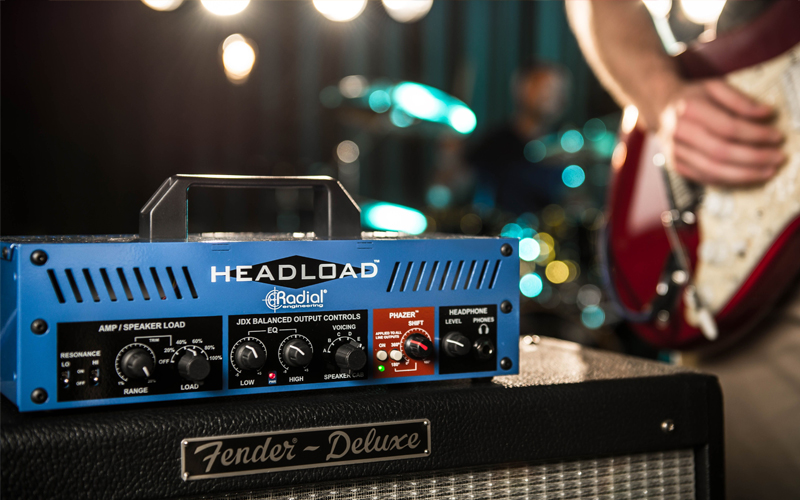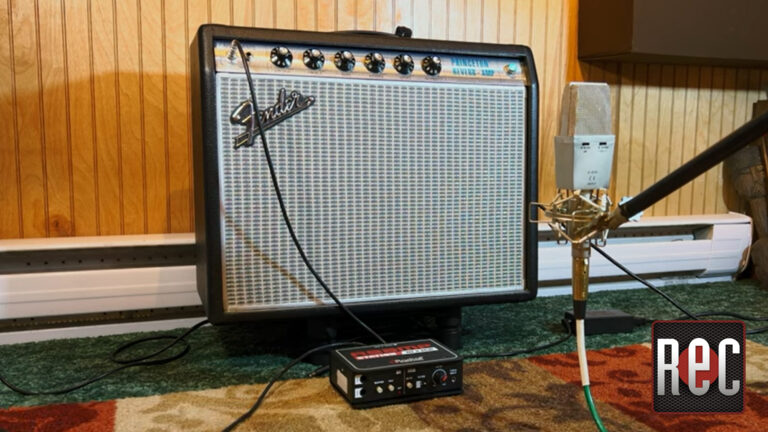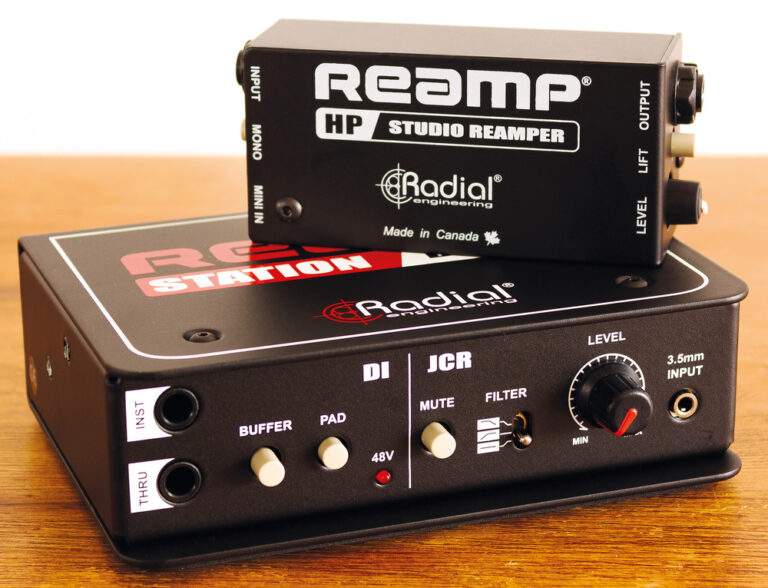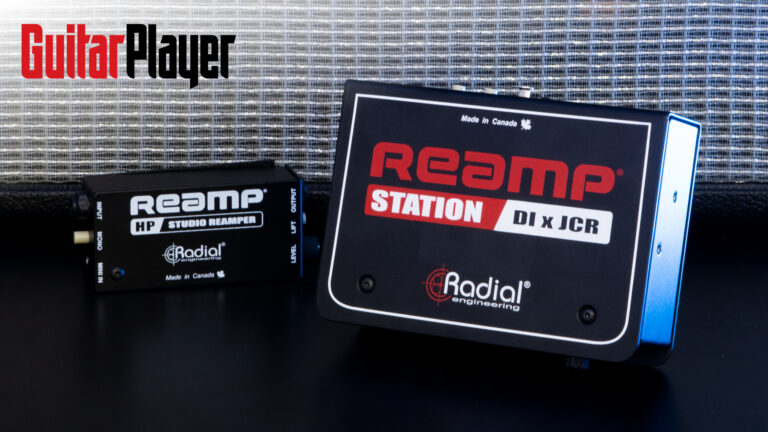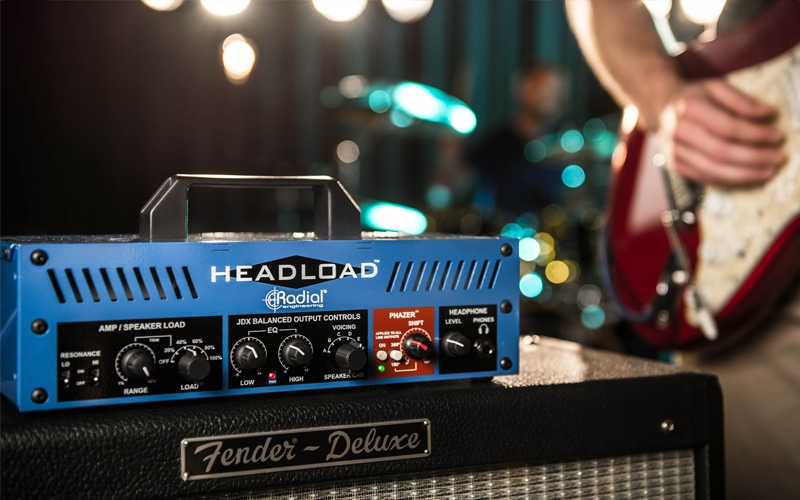
This review was originally written by Alex Hawley in the July 2016 issue of Recording Magazine (Volume 29: 10).
Radial Engineering is known for nearly bulletproof durability, overall reliability, and a unique line of products that cover just about any I/O setup imaginable. Based in Vancouver, Radial features products such as recording interfaces, 500 Series modules, reamping tools, rugged DI boxes, guitar amp attenuators, and much more. Today, we’ll be checking out the Radial Headload, which is a combination direct box, load box, and phase alignment tool.
Overview
I’ve been eager to try out the Headload for a number of reasons. I love the idea of using an attenuator with high-wattage amps at home, or even on stage to help manage stage volume during performances. The Headload can go well beyond simple attenuation, taking on the entire load from an amp for silent recording. For use without a speaker cabinet, the Headload features a JDX Reactor output, loaded with a number of cab simulations to stand in for any missing sonic elements that result from playing silently. Its flexible I/O allows you to capture the best of both worlds at once—the built-in Phazer tool is designed to fine-tune any slight phase adjustments that are needed between a miked cab and a simulated cab going into the PA or recording interface.
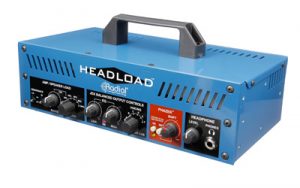 The Headload lives in a 14 gauge steel chassis and weighs about 8 pounds. It has optional rack ears or a grab-and-go handle for transport to a gig. From a construction standpoint, this thing is rock solid. It can safely handle up to 130 Watts RMS and peaks at 180 Watts. The durability starts with a series of cement-encrusted copper resistor coils, controlled with a fixed 6- position rotary switch to set the power reduction. The settings range from 100% (full volume) down to 20%, with a Trim knob for fine adjustments from 20% down to zero. The Off setting is used when there is no cab connected, to prevent damage to the amp or the Headload. Next to the attenuation controls there are two different Hi and Lo Resonance toggles. The Resonance switches enhance the EQ curve on the stage amp, in order to compensate for a reduced speaker level; they compensate for the Equal Loudness Contours in a manner similar to a Loudness switch on a hi-fi system.
The Headload lives in a 14 gauge steel chassis and weighs about 8 pounds. It has optional rack ears or a grab-and-go handle for transport to a gig. From a construction standpoint, this thing is rock solid. It can safely handle up to 130 Watts RMS and peaks at 180 Watts. The durability starts with a series of cement-encrusted copper resistor coils, controlled with a fixed 6- position rotary switch to set the power reduction. The settings range from 100% (full volume) down to 20%, with a Trim knob for fine adjustments from 20% down to zero. The Off setting is used when there is no cab connected, to prevent damage to the amp or the Headload. Next to the attenuation controls there are two different Hi and Lo Resonance toggles. The Resonance switches enhance the EQ curve on the stage amp, in order to compensate for a reduced speaker level; they compensate for the Equal Loudness Contours in a manner similar to a Loudness switch on a hi-fi system.
The JDX controls allow you to toggle between six different cab emulations that cover a wide range of sonic characters. The first voicing is based on Radial’s popular JDX Reactor box, which emulates the sound of a 4×12 Marshall cabinet. The other voices cover a range of amps based on open back, closed back, different drivers, and so on. Audition each voicing and see what works best with your amp. The emulation is analog, so end results are directly related to the amp in use. The 2-band EQ on the front panel fine-tunes any of these cab voicings.
Also on the front panel is the Phazer tool. This phase adjustment setting can create 360 degrees of analog phase shift, giving plenty of flexibility to phase-align any miked cabinet with the internal JDX output. Combining a miked cab with the JDX output can create huge tones… the built-in Phazer really sets the Headload apart in this respect.
In use
The Headload is available in 16, 8, and 4Ω versions. Give this some thought if you plan on running multiple cabs with the Headload, as the outputs run in parallel. This means both of your cabs would need to be rated at 16Ω in order to use the 8Ω Headload, or if both cabs were 8Ω, then you’d need to purchase the 4Ω version. The I/O on the back panel is pretty flexible, and allows for a lot of applications. There are pre and post EQ XLR outputs, plus two unbalanced outputs (one pre-JDX, one post-JDX and EQ), an input from the guitar amp, and two outputs to feed speaker cabinets, all on 1/4″. Both of the XLR outputs capture the sound of the JDX, but the pre-EQ output is intended for the PA, and the post-EQ output is intended for use with stage monitors or in-ear monitors. There is also a 1/4″ headphone input on the front panel.
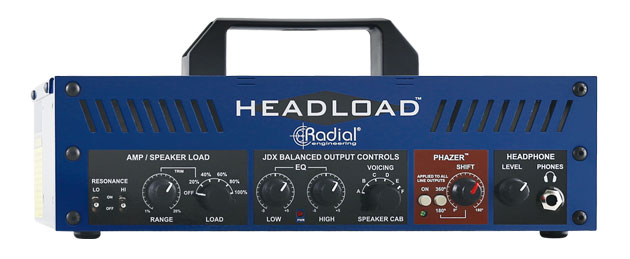 The amp attenuation sounds accurate at all of the various settings, especially when implementing the resonance switches for the lower settings. The playability of the amp and tone stays intact, while maintaining a practical stage volume or practice volume, even with powerful tube amps.
The amp attenuation sounds accurate at all of the various settings, especially when implementing the resonance switches for the lower settings. The playability of the amp and tone stays intact, while maintaining a practical stage volume or practice volume, even with powerful tube amps.
The ability to drive the amplifier into the sweet spot without entering into dangerously loud SPL levels is great. While it is unrealistic to expect the exact tone when attenuated to 20%, for example, the Headload remains powerful and punchy, and represents the tone very musically. The resonance switches are a great feature when you are attenuating as low as 20%, as they do help compensate for tonal changes when speaker level is reduced.
The JDX outputs, for silent stage volume or recording, sound very full and realistic. It’s pretty amazing to have the ability to record a 100 Watt Marshall head at four in the morning and not wake up a sleeping baby in the next room. Unlike similar products on the market, the Headload’s cab modeling outputs are completely analog. While you may not have the ability to tweak various speakers and mic placements as you would in the digital domain, there’s something appealing about the analog cab filters on the Headload. They all sound great and cover a wide range of cabinet characteristics and I believe it feels more organic to play through them as opposed to implementing a cab digitally.
The Phazer tool is an awesome addition to the Headload. While phase aligning the JDX output and the miked cab would be easy to do in the digital domain while recording, the Phazer really comes into its own for using the Headload on stage. The possibilities for cab/JDX combo can create absolutely huge tones, and dialing in the phase really makes it a more practical option to bring those monster tones to the stage.
Wrapup
Radial’s Headload is a Swiss Army knife for tube amps. It excels on stage and in the studio, and is packed with extremely functional features that make real-world application of high wattage amplifiers much more straightforward without sacrificing tone.
It’s not cheap, but its price is more than justified with its rugged build quality. Similar options at this price point live in the digital realm, which puts the Headload in a separate category based on its completely analog cab emulations. As you step down the price scale, you can find attenuators that will be missing the Headload’s extra real-world features. The durability and flexibility of the Headload make it an easy choice and a solid investment, because no matter what your guitar recording application might be, this will be a workhorse that you can rely upon every time.
Read more about the Headload here.

